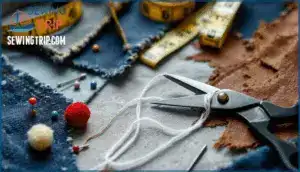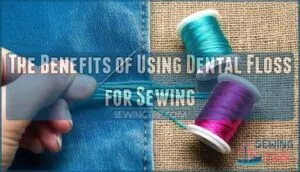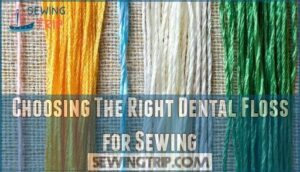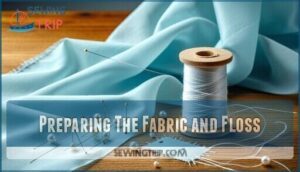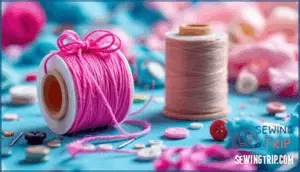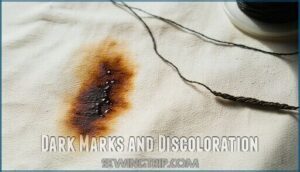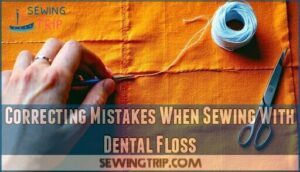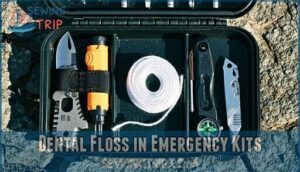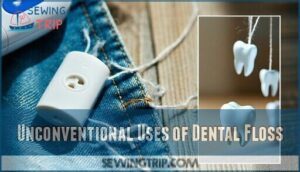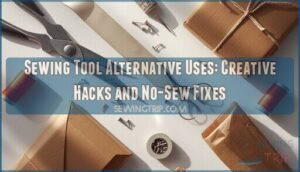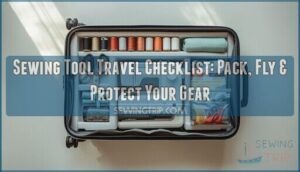This site is supported by our readers. We may earn a commission, at no cost to you, if you purchase through links.

The floss acts like super-strong thread that won’t snap under pressure. Waxed floss works best since it glides smoothly through tough fabrics without shredding.
Just thread it like regular thread and use a heavy-duty needle. While it’s not ideal for delicate fabrics or fine stitching, dental floss shines when you need something that’ll hold up to serious wear and tear.
There’s more to know about choosing the right type and mastering the technique.
Table Of Contents
- Key Takeaways
- Dental Floss for Sewing: What You’ll Need
- The Benefits of Using Dental Floss for Sewing
- Choosing The Right Dental Floss for Sewing
- Step-by-Step Guide: How to Sew With Dental Floss
- Pros and Cons of Sewing With Dental Floss
- Correcting Mistakes When Sewing With Dental Floss
- Alternative Threads for Gear Repairs
- Dental Floss in Emergency Kits
- Unconventional Uses of Dental Floss
- Frequently Asked Questions (FAQs)
- Conclusion
Key Takeaways
- You can absolutely use dental floss for sewing – it’s actually stronger than regular thread, with tensile strength ranging from 2-10 pounds, making it perfect for heavy-duty repairs on denim, canvas, and leather.
- Choose waxed multifilament floss for best results – the wax coating helps it glide smoothly through tough fabrics without fraying, though you’ll want unwaxed floss for delicate or light-colored materials to avoid staining.
- You’ll need a heavy-duty needle and proper technique – thread it like regular thread, but use whip stitches for thick fabrics, and secure your stitches with double loop knots or the melting technique for permanent seals.
- It’s ideal for emergency repairs and outdoor gear – dental floss works as an excellent temporary solution for backpack straps, tent seams, and clothing tears when you’re away from proper sewing supplies.
Dental Floss for Sewing: What You’ll Need
The right materials make all the difference when you’re diving into dental floss sewing. You’ll need a thick needle that can handle the floss without bending or breaking—think heavy-duty needles designed for denim or leather work.
For Needle Selection, choose something sturdy enough to punch through tough fabrics without splitting your floss. When it comes to Floss Types, waxed multifilament floss is your best friend for strength and durability.
It glides through fabric like butter and won’t fray easily. For delicate projects, unwaxed floss works better since it’s gentler on lightweight materials. Essential Tools include sharp fabric scissors, pins for securing your work, and good lighting so you can see those precise stitches.
To guarantee clean cuts, it’s best to use fabric scissors specifically. Fabric Compatibility matters too—dental floss shines on heavy materials like canvas, denim, and leather where regular thread might snap.
Your Preparation Steps should include testing the floss on fabric scraps first, ironing your material smooth, and having patience ready because this strong thread alternative takes practice to master.
The Benefits of Using Dental Floss for Sewing
You’ll discover that dental floss offers surprising advantages over traditional thread for many sewing projects.
From its exceptional strength to cost savings, floss brings unique benefits that make it worth keeping in your sewing kit.
Versatility and Durability
Most fabrics can’t stop dental floss from delivering reliable stitches.
When fabric meets its match, dental floss refuses to back down—delivering stitches that outlast ordinary thread.
You’ll find this unconventional thread tackles everything from lightweight cotton to heavy-duty canvas with impressive fabric compatibility.
Unlike regular thread that snaps under pressure, dental floss brings serious stitch strength to your projects.
The secret lies in its construction.
Made from nylon or Teflon, dental floss handles material thickness that would challenge conventional threads.
Whether you’re patching denim or reinforcing outdoor gear, this durable sewing thread won’t quit on you.
Its tensile strength ranges from 2-10 pounds—significantly stronger than standard polyester thread.
Project suitability extends beyond basic mending.
You can use floss as thread for heavy-duty repairs, emergency fixes, or creative applications.
The water resistance makes it perfect for long-term use on items exposed to moisture.
Plus, this strong thread alternative resists fraying and maintains integrity through repeated stress.
The backstitch provides durability, even when using floss.
Think of dental floss sewing as your secret weapon for tough jobs where regular thread throws in the towel.
Cost-Effective Option
Beyond convenience, dental floss delivers serious savings for your sewing projects.
You’ll discover that this humble bathroom staple costs pennies compared to specialty threads, making it perfect for budget sewing experiments and thrifty projects.
Here’s why dental floss beats traditional thread for your wallet:
- Free surplus supply – Those extra floss containers from dental visits become your crafting goldmine
- Affordable crafts potential – One $2 floss pack handles multiple DIY repairs that’d cost $15+ in specialty threads
- Floss vs thread economics – You’re getting premium durability at drugstore prices
When you’re tackling heavy-duty projects like canvas bags or denim patches, this floss thread substitute proves its worth.
The cost-effective nature means you can experiment freely without worrying about wasting expensive materials.
Whether you’re doing emergency repairs or planned affordable crafts, dental floss stretches your crafting budget further than traditional options.
Your wallet will thank you for choosing this unconventional yet practical sewing solution.
DIY Look and Unique Stitching Experience
Your hands craft something special when you choose dental floss over traditional thread.
Transform everyday repairs into extraordinary craftsmanship with this unconventional thread that never gives up.
The visible stitches create a distinctive unconventional thread appearance that screams handmade authenticity. Floss aesthetics shine on dark fabrics where regular thread disappears, but your stitches stand proud.
Creative applications emerge naturally—you’ll find yourself experimenting with decorative patterns and functional repairs. The sensory benefits surprise many sewers; that waxy texture glides smoothly through fabric while releasing a fresh scent.
This crafting diversification pushes your skills beyond conventional boundaries, turning basic mending into artistic expression. Your unique DIY look becomes a conversation starter, showcasing the unconventional thread appearance and the fresh scent of the floss, which adds to the overall handmade charm.
Choosing The Right Dental Floss for Sewing
Not all dental floss works the same for sewing projects, so you’ll want to pick the right type for your fabric and goals.
Your choice between waxed versus unwaxed and multifilament versus monofilament floss can make or break your stitching success.
Waxed Vs. Unwaxed Dental Floss
Choosing the right type of dental floss affects your sewing success. Waxed floss glides smoothly through tough materials like denim and canvas, offering superior knot strength and durability.
However, its coating can leave visible marks on lighter fabrics. As a result, plaque removal efficiency isn’t the only factor to keep in mind.
Here’s what you need to know about each type:
- Waxed floss sewing works best for heavy-duty repairs on dark materials
- Unwaxed dental floss prevents discoloration on delicate, light-colored fabrics
- Fabric choice determines which floss type you’ll need for your project
- Mark visibility becomes a concern with waxed floss on white or pastel materials
- Unwaxed floss sewing offers better grip but may fray more easily during use
Multifilament Vs. Monofilament Dental Floss
When selecting between dental floss types, consider your project’s demands carefully.
Monofilament floss delivers superior floss strength and durability for heavy fabrics like denim, though its slippery surface complicates knot tying.
Multifilament offers better fabric compatibility with lighter materials and easier stitch visibility, but tangles frequently during use.
For best uses, choose monofilament for tough repairs requiring maximum strength, while multifilament works well for decorative stitching where you need better thread control and handling.
The ADA emphasizes flossing consistently, not floss type.
Step-by-Step Guide: How to Sew With Dental Floss
You’re ready to tackle sewing with dental floss, and it’s easier than you might think.
Follow these straightforward steps to master this unconventional but effective technique that’ll give your projects extra durability and a unique DIY flair.
This technique will help you achieve a unique DIY project with extra durability.
Preparing The Fabric and Floss
Iron your fabric first to eliminate wrinkles that’ll mess with your stitching.
Pin pieces together using proper pinning techniques – think every few inches for stability.
Choose a thick sewing needle that can handle dental floss without bending.
Select waxed multifilament dental floss for best results.
Consider the benefits of using quality waxed floss for enhanced grip.
Always test your setup on scrap fabric first – better safe than sorry!
Sewing Techniques and Tips
Master these core sewing techniques for floss success. Thread without doubling, leaving a half-inch tail for securing.
Use whip stitches on heavy fabrics like canvas or denim.
The melting technique works perfectly—hold your lighter close until the floss browns, then quickly press against fabric.
This knot alternative creates stronger seals than traditional methods, though stitch visibility increases on lighter materials, using a method that is a complete concept.
Securing and Finishing Stitches
Once you’ve completed your sewing techniques, securing your dental floss stitches properly prevents unraveling.
Use double loop knots for maximum hold, leaving short tails to avoid bulk.
For permanent sealing methods, try the melting technique—carefully heat the floss end until it browns, then press against fabric.
This creates strong and durable stitches with excellent stitch visibility, though avoid this on areas prone to fabric scratchiness.
Pros and Cons of Sewing With Dental Floss
You’ll quickly discover that dental floss brings both impressive benefits and surprising drawbacks to your sewing projects.
While its strength can outlast regular thread by years, that same durability might leave permanent marks on lighter fabrics that you can’t undo, which is a significant drawback.
Durability and Longevity
When you’ve finished your dental floss sewing project, you’ll want to know how well it’ll hold up over time. Dental floss delivers impressive seam strength and stitch endurance that often surprises first-time users.
Here’s what makes dental floss thread strength stand out:
- Tensile strength ranges from 3.5 to 25 pounds per strand – much stronger than regular thread
- Strong and durable stitches resist breaking under normal fabric stress and movement
- Environmental factors like moisture don’t weaken nylon floss like they do cotton thread
- Long-term wear testing shows floss outlasts traditional thread in static applications
Your fabric durability gets a boost too, since fewer repairs mean less handling. For ideal results, consider that the backstitch offers durability for hand sewing projects.
However, material degradation can occur faster in high-friction areas where constant rubbing wears down the fibers.
Dark Marks and Discoloration
When working with dental floss for repairs, you’ll encounter discoloration challenges.
Heat sealing methods create brown marks, especially on light fabrics. Waxed floss transfers stains that resist removal.
| Challenge | Solution |
|---|---|
| Heat seal marks | Seal on fabric underside |
| Wax stains | Use unwaxed floss instead |
| Color bleeding | Match floss to fabric type |
Choose darker materials where marks blend naturally. Test prevention tips on scraps first—your emergency sewing thread deserves proper planning!
Correcting Mistakes When Sewing With Dental Floss
In the context of correcting sewing mistakes with dental floss, you’ll find the process surprisingly straightforward.
The waxy coating that makes floss slip through tight spaces also helps it glide out smoothly during floss stitch removal.
Here’s your step-by-step approach for fixing those "oops" moments:
- Slip the seam ripper under each stitch – Work slowly to avoid fabric damage while cutting through the floss
- Grab stubborn pieces with tweezers – The waxy surface won’t shred like regular thread, making extraction cleaner
- Pull gently from both ends – Let the floss’s smooth texture work in your favor as it slides free
- Re-thread your needle immediately – Fresh floss threads easily without fraying or splitting
Rethreading techniques stay simple since floss maintains its integrity even after removal.
You won’t deal with the usual thread tangles or weak spots that plague traditional sewing mistakes corrections.
Alternative Threads for Gear Repairs
When your outdoor gear tears on the trail, you need thread that won’t snap under pressure or fall apart in harsh weather.
Dental floss makes a surprisingly effective temporary fix for backpack straps, tent seams, and clothing tears, though specialized threads like Nymo offer better long-term durability for serious repairs, providing a long-term solution.
Nymo Thread for Outdoor Gear
While dental floss works for quick fixes, serious outdoor gear repairs need something tougher.
Nymo thread’s nylon construction delivers superior knot strength and UV resistance that’ll outlast your hiking boots.
This single-strand powerhouse handles abrasion like a champ, making it perfect for backpack straps and tent seams.
With color options to match your gear and decades-proven outdoor applications, Nymo’s your go-to for improvised sewing when dental floss just won’t cut it.
For more demanding applications, consider the fabric’s tensile strength for peak performance, and remember that Nymo thread is a reliable choice for outdoor gear repairs.
Dental Floss as a Temporary Solution
When you’re stuck without proper thread, dental floss becomes your sewing superhero.
This unconventional method works perfectly for expedient repairs when traditional supplies aren’t available.
Here’s what makes floss shine for temporary fixes:
- Quick Fixes for torn backpack straps during hiking adventures
- Fabric Basting to hold pieces together before permanent stitching
- Temporary Hems that’ll last until you reach your sewing machine
- Holding Seams in place during those "I’ll fix it later" moments
- DIY repairs that turn emergencies into manageable situations
While it won’t replace quality thread long-term, floss delivers when you need it most.
Dental Floss in Emergency Kits
When you’re out in the wilderness or facing an emergency situation, dental floss becomes an invaluable addition to your repair kit that’s lightweight and surprisingly versatile.
It’s stronger than regular thread and won’t take up precious space in your backpack, making it perfect for quick gear fixes when you’re miles from the nearest store.
Nymo Thread in Hiking and Survival Kits
Pack Nymo thread into your hiking and survival kits for reliable outdoor gear repair.
This nylon powerhouse outperforms dental floss with superior strength and durability:
- Nymo Thread Strength – 8.5lb tensile strength handles heavy pack repairs
- Outdoor Gear Repair – withstands UV, rain, and abrasion better than alternatives
- Thread Weight Comparison – Size D offers ideal balance of strength and workability
- Survival Kit Inclusion – doubles as cordage and fishing line when needed
Your gear depends on it.
Consider Nymo thread’s uses for your next outdoor adventure.
Limitations and Considerations
The downside? Fabric Discoloration happens with lighter materials, and Stitch Visibility becomes obvious on delicate fabrics.
Limited Colors restrict your design options, while Knot Security can fail under stress.
Best Applications include emergency mends and heavy-duty repairs, but durability varies. These unconventional methods work great for quick fixes, though alternative thread options often perform better for critical repairs, involving heavy-duty repairs.
Unconventional Uses of Dental Floss
You’ll be surprised at how dental floss extends beyond oral care into practical everyday solutions.
Beyond sewing, this versatile string tackles everything from emergency repairs to household problems you never thought it could solve, with practical everyday solutions and emergency repairs being key applications.
Fishing Line and Cordage
When you’re hiking and need improvised rope, dental floss transforms into versatile cordage.
This fishing line substitute boasts impressive tensile strength—up to 10 pounds for quality brands.
You’ll find it perfect for emergency gear repair, securing tarps, or even catching dinner.
Master basic knot tying techniques with floss, and you’ve got wilderness survival gold in your pocket.
Picture Hanger and Wall Protection
Hanging artwork with dental floss creates an improvised rope solution that protects your walls from scratches and nail holes.
This alternative hanging method works perfectly for lightweight frames and aesthetic considerations.
- Floss weight limits: Stick to frames under 2 pounds to prevent breaking
- Preventing wall damage: The thin strand won’t leave marks like wire hangers
- Hanging fragile items: Gentle tension reduces stress on delicate frame corners
Cleaning Small Spaces and Removing Debris
Squeeze unwaxed dental floss into cramped electronics crevices where dust bunnies love to hide.
This floss as pick technique works wonders for debris removal uses around keyboards, phone ports, and calculator buttons.
The thin strands slip into tight space cleaning areas that brushes can’t reach, making floss detail work perfect for craft debris removal too.
Waxed floss leaves residue, so stick with unwaxed for dustfree results.
Gently twist the floss to snag lint and hair from those sneaky corners where grime accumulates, keeping your electronics running smoothly with smoothly.
Frequently Asked Questions (FAQs)
Can you sew with dental floss?
When a seamstress ran out of thread while mending her favorite jeans, she grabbed dental floss and discovered it’s actually stronger than regular thread.
You can absolutely sew with dental floss—it’s perfect for heavy fabrics like denim or canvas since it won’t snap under pressure.
What do you use dental floss for?
You use dental floss primarily for oral hygiene—cleaning between teeth and removing plaque buildup.
But it’s surprisingly versatile: emergency repairs, cutting cheese, hanging pictures, and yes, even sewing tough fabrics when regular thread breaks, showcasing its use beyond dental care.
Is it OK to use sewing thread instead of floss?
Sewing thread’s practically tissue paper compared to dental floss’s superhuman strength. You’d need multiple thread layers where one floss strand works perfectly for heavy fabrics like canvas or leather.
How does an orthodontic flosser function?
Orthodontic flossers work like tiny fishing rods for your teeth—you thread the floss through a plastic holder, then maneuver it between brackets and wires.
The handle gives you better control than regular floss, making it easier to clean those hard-to-reach spots.
How to use dental floss with braces?
Picture threading a needle through a maze of metal wires—that’s flossing with braces.
You’ll need to thread floss under each wire using a floss threader or water flosser for effective cleaning.
What is waxed dental floss?
Waxed dental floss features a thin coating of wax that makes it glide smoothly between teeth and resist fraying.
You’ll find it particularly useful for sewing since the wax coating strengthens the floss and eliminates friction during stitching, making the wax coating a valuable asset.
Why do punks sew with dental floss?
Like telegram operators of old, you’ll find punks chose dental floss because it’s incredibly strong, cuts through thick fabrics like leather jackets effortlessly, and won’t break when you’re reinforcing patches.
Can you use dental floss to stitch a wound?
No, you shouldn’t use dental floss to stitch wounds. While floss is strong and sterile, it’s not designed for medical use and lacks proper surgical thread properties for safe healing.
Can you use dental floss instead of twine?
Think of it as swapping a race car for a pickup truck – dental floss can absolutely replace twine in many situations.
You’ll find floss works great for light-duty tasks like crafts, temporary repairs, or securing small items, though it won’t handle heavy loads.
Is dental floss better than thread?
Dental floss isn’t universally better than thread—it depends on your project.
You’ll find floss excels for heavy fabrics like canvas or leather, offering superior strength and durability.
But regular thread remains ideal for delicate materials and precise stitching work, making it a better choice for certain tasks, with durability being a key factor in the decision.
Conclusion
Threading through fabric like a lifeline, dental floss transforms from bathroom staple to sewing superhero when you need unbreakable strength.
Now you know the answer to "can you use dental floss for sewing" is absolutely yes.
You’ve learned when to choose waxed over unwaxed, how to handle tough materials, and why it’s perfect for heavy-duty repairs.
Keep some in your emergency kit—you’ll be amazed how often this unconventional thread saves the day.
- https://www.youtube.com/watch?v=dtFi8Gtw6K4
- https://www.pinterest.com/soseweasy/sewing-tutorials-and-tips-sse/
- http://www.thisoldhouse.com/toh/article/0,,1593203,00.html
- http://slipstitchesandmore.blogspot.com/2009/05/sewing-and-dental-floss.html
- http://voices.yahoo.com/sewing-waxed-dental-floss-7693686.html?cat=30

